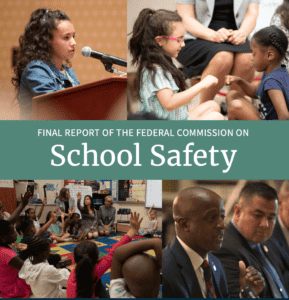Federal Commission on School Safety Releases Comprehensive Resource Guide for Keeping Students, Teachers Safe at School

After months of research, visiting successful programs around the nation, and receiving testimony from experts and concerned citizens, today the Federal Commission on School Safety (Commission) released a 177-page report detailing 93 best practices and policy recommendations for improving safety at schools across the country.
Utilizing the information gathered, the Commission report offers a holistic approach to improving school safety, ranging from supporting the social and emotional well-being of students to enhancing physical building security. Acknowledging there can be no one-size-fits-all solution to this complex problem, the final report serves as a resource guide for families, educators, law enforcement officers, health professionals, and elected leaders to use as they consider the best ways to prevent, mitigate, and recover from acts of violence in schools. The recommendations are based on efforts that are already working in states and local communities.
To view the report in its entirety, click here.
COMMISSION BACKGROUND
In the wake of the tragic shooting at Marjory Stoneman Douglas High School in February, President Donald J. Trump established the Commission and tasked its members with studying and recommending ways to make our nation’s schools more secure.
Over the nine months that followed, the Commissioners, including U.S. Secretary of Education Betsy DeVos, Acting Attorney General Matthew Whitaker (who succeeded former Attorney General Jeff Sessions as a Commissioner), Secretary of Health and Human Services Alex Azar, and Secretary of Homeland Security Kirstjen Nielsen, held more than a dozen meetings, field visits, and listening sessions.
Commission meetings provided a forum for presentations from subject matter experts, educators, law enforcement officials, and individuals affected by school violence. Field visits involved travel to schools to learn first-hand about current best practices in school safety. Listening sessions occurred in regions across the country and provided opportunities for the public to offer recommendations to the Commission. In total, the Commissioners heard from dozens of experts from nearly 40 states and reviewed more than 1,500 comments from the public via safety@ed.gov.
REPORT OVERVIEW
The Federal Commission on School Safety Report contains 19 chapters divided into three sections based on well-established phases of security planning:
PREVENT
- Character Development and a Culture of Connectedness
- Cyberbullying and School Safety
- Curating a Healthier and Safer Approach: Issues of Mental Health and Counseling for Our Young
- Integrating Mental Health, Primary Care, Family Services, and Court-Ordered Treatment
- Using Suspicious Activity Reporting and Threat Assessments to Enhance School Safety
- Effects of Press Coverage of Mass Shootings
- Violent Entertainment and Rating Systems
- The Obama Administration’s “Rethink School Discipline” Guidance
- The Effectiveness and Appropriateness of Psychotropic Medication for Treatment of Troubled Youth
- The Efficacy of Age Restrictions for Firearm Purchases
- Extreme Risk Protection Order Laws
- Improvements to the FBI’s Public Access Line
PROTECT & MITIGATE
- Training School Personnel to Help Ensure Student Safety
- Emergency and Crisis Training for Law Enforcement
- The Transition of Military Veterans and Retired Law Enforcement Officials into New Careers in Education
- Best Practices for School Building Security
- The Family Educational Rights and Privacy Act and Other Statutory and Regulatory Privacy Protections
- The Health Insurance Portability and Accountability Act (HIPAA) and Other Statutory and Regulatory Privacy Protections
RESPOND & RECOVER
- Active Shooter Preparedness and Mitigation
To view the report in its entirety, click here.
